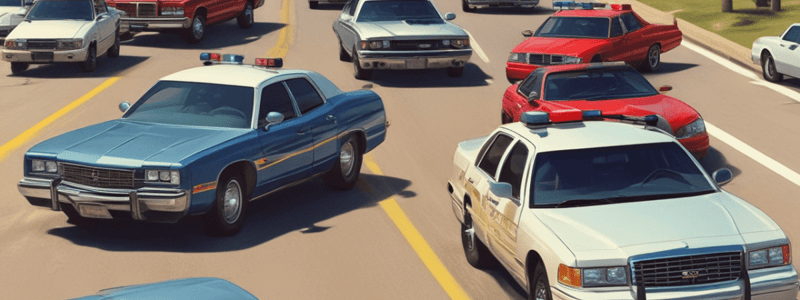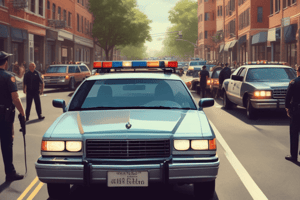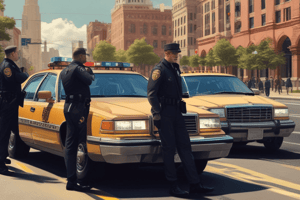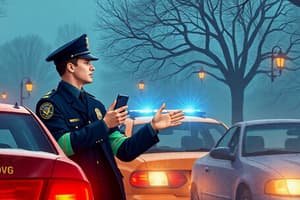Podcast
Questions and Answers
When is it generally not practical to stop a driver for a traffic violation?
When is it generally not practical to stop a driver for a traffic violation?
- When the driver is not pulling over immediately
- When you are driving to an emergency call or transporting a prisoner (correct)
- When the driver is driving recklessly
- When the driver is committing a minor traffic offense
What should you consider when following a vehicle through traffic until it is safe to make the traffic stop?
What should you consider when following a vehicle through traffic until it is safe to make the traffic stop?
- Calling for backup immediately
- Speeding up to catch up with the vehicle
- Signaling all lane changes only when necessary
- Using defensive driving techniques (correct)
Why should you not make a traffic stop in heavy traffic or construction areas?
Why should you not make a traffic stop in heavy traffic or construction areas?
- Because it may lead to a high-speed chase
- Because it may cause traffic congestion
- Because it may endanger you or other motorists (correct)
- Because it may delay your response to an emergency call
What is the primary purpose of step 4 in an unknown risk traffic stop?
What is the primary purpose of step 4 in an unknown risk traffic stop?
What should you prioritize when dealing with a reckless driver who is endangering the lives of others?
What should you prioritize when dealing with a reckless driver who is endangering the lives of others?
How many steps are involved in completing an unknown risk traffic stop?
How many steps are involved in completing an unknown risk traffic stop?
What should you do while following the vehicle until you initiate a safe stop?
What should you do while following the vehicle until you initiate a safe stop?
What information should you gather about the vehicle before making a traffic stop?
What information should you gather about the vehicle before making a traffic stop?
Why is it not recommended to make a traffic stop on a bridge?
Why is it not recommended to make a traffic stop on a bridge?
Why is location information crucial during a traffic stop?
Why is location information crucial during a traffic stop?
What should you do if the final stop location changes during a traffic stop?
What should you do if the final stop location changes during a traffic stop?
Why should you provide a description of the driver's vehicle to dispatch?
Why should you provide a description of the driver's vehicle to dispatch?
What should you do when selecting a safe location to initiate a traffic stop?
What should you do when selecting a safe location to initiate a traffic stop?
What information should you provide to dispatch about the occupants of the vehicle?
What information should you provide to dispatch about the occupants of the vehicle?
Why is it important to relay your radio identification number to dispatch during a traffic stop?
Why is it important to relay your radio identification number to dispatch during a traffic stop?
When should you request backup or other assistance during a traffic stop?
When should you request backup or other assistance during a traffic stop?
What should the backup officer avoid using to prevent blinding or silhouetting the primary officer?
What should the backup officer avoid using to prevent blinding or silhouetting the primary officer?
How should the backup officer approach the driver's vehicle?
How should the backup officer approach the driver's vehicle?
What should the officer check for before exiting their patrol vehicle?
What should the officer check for before exiting their patrol vehicle?
Why should the officer exit their patrol vehicle quickly?
Why should the officer exit their patrol vehicle quickly?
What should the officer do with their vehicle door after exiting?
What should the officer do with their vehicle door after exiting?
What should the officer adjust after exiting their patrol vehicle?
What should the officer adjust after exiting their patrol vehicle?
What should the officer look for when visually assessing the vehicle?
What should the officer look for when visually assessing the vehicle?
What might be indicated if the vehicle's rear end appears to be significantly lower than the front?
What might be indicated if the vehicle's rear end appears to be significantly lower than the front?
What is the benefit of approaching the vehicle on the passenger's side?
What is the benefit of approaching the vehicle on the passenger's side?
What may indicate a stolen vehicle during a traffic stop?
What may indicate a stolen vehicle during a traffic stop?
When should you call for backup during a traffic stop?
When should you call for backup during a traffic stop?
What is the purpose of the 'no-approach' tactic during a traffic stop?
What is the purpose of the 'no-approach' tactic during a traffic stop?
Why should you assume a tactical position behind a patrol vehicle pillar when using the 'no-approach' tactic?
Why should you assume a tactical position behind a patrol vehicle pillar when using the 'no-approach' tactic?
What should you be observant of when the driver approaches the patrol vehicle during the 'no-approach' tactic?
What should you be observant of when the driver approaches the patrol vehicle during the 'no-approach' tactic?
What are the three main objectives during the initial interaction with the driver?
What are the three main objectives during the initial interaction with the driver?
What should you do when the driver is looking at you directly or through a side or rearview mirror during the 'no-approach' tactic?
What should you do when the driver is looking at you directly or through a side or rearview mirror during the 'no-approach' tactic?
Why should officers keep their patrol vehicle engines running during a traffic stop?
Why should officers keep their patrol vehicle engines running during a traffic stop?
What is the purpose of a takedown area during a traffic stop?
What is the purpose of a takedown area during a traffic stop?
Where is the safe zone typically located during a traffic stop?
Where is the safe zone typically located during a traffic stop?
Why should the backup patrol vehicles be positioned at least two door widths apart?
Why should the backup patrol vehicles be positioned at least two door widths apart?
What should the backup vehicles focus on the suspect's vehicle?
What should the backup vehicles focus on the suspect's vehicle?
Why should the forward-facing emergency lights be turned off if a patrol vehicle is positioned at the rear of the primary patrol vehicle?
Why should the forward-facing emergency lights be turned off if a patrol vehicle is positioned at the rear of the primary patrol vehicle?
What determines the positioning of the backup patrol vehicles?
What determines the positioning of the backup patrol vehicles?
How should the primary patrol vehicle typically be positioned relative to the suspect's vehicle?
How should the primary patrol vehicle typically be positioned relative to the suspect's vehicle?
What type of location is preferred for conducting a traffic stop?
What type of location is preferred for conducting a traffic stop?
What should an officer consider when planning a traffic stop?
What should an officer consider when planning a traffic stop?
Why should an officer avoid stopping a vehicle in a populated area?
Why should an officer avoid stopping a vehicle in a populated area?
What should an officer check when selecting a location for the traffic stop?
What should an officer check when selecting a location for the traffic stop?
Why should an officer try to pull off onto a level spot or a slight downgrade?
Why should an officer try to pull off onto a level spot or a slight downgrade?
What should an officer be aware of at all times during a traffic stop?
What should an officer be aware of at all times during a traffic stop?
What can affect traffic flow and slow drivers down?
What can affect traffic flow and slow drivers down?
What should an officer request based on their evaluation of the situation?
What should an officer request based on their evaluation of the situation?
What is the purpose of leaving the emergency lights on during a traffic stop?
What is the purpose of leaving the emergency lights on during a traffic stop?
When should you consider turning on the patrol vehicle's high beams during a traffic stop?
When should you consider turning on the patrol vehicle's high beams during a traffic stop?
What is the purpose of the takedown lights?
What is the purpose of the takedown lights?
Why should you stay far enough behind the vehicle during a traffic stop?
Why should you stay far enough behind the vehicle during a traffic stop?
What should you do if the driver flees instead of stopping as instructed?
What should you do if the driver flees instead of stopping as instructed?
What is the purpose of giving clear, firm verbal directions using the PA system?
What is the purpose of giving clear, firm verbal directions using the PA system?
Why should you avoid traffic lanes during a traffic stop?
Why should you avoid traffic lanes during a traffic stop?
What should you prioritize when conducting a traffic stop?
What should you prioritize when conducting a traffic stop?
What type of information do databases provide in relation to people with outstanding arrest warrants?
What type of information do databases provide in relation to people with outstanding arrest warrants?
What should you consider when deciding on a course of action during a traffic stop?
What should you consider when deciding on a course of action during a traffic stop?
Why should you request that the driver and passengers stay in the driver's vehicle or move to a designated area?
Why should you request that the driver and passengers stay in the driver's vehicle or move to a designated area?
What is an advantage of approaching the vehicle on the passenger's side during a traffic stop?
What is an advantage of approaching the vehicle on the passenger's side during a traffic stop?
What should you do if the driver expresses a desire to make a complaint against you?
What should you do if the driver expresses a desire to make a complaint against you?
What may indicate a stolen vehicle during a traffic stop?
What may indicate a stolen vehicle during a traffic stop?
What should you do when completing the traffic stop?
What should you do when completing the traffic stop?
When should you call for backup during a traffic stop?
When should you call for backup during a traffic stop?
How are traffic stops typically documented?
How are traffic stops typically documented?
What is the purpose of the 'no-approach' tactic during a traffic stop?
What is the purpose of the 'no-approach' tactic during a traffic stop?
What should you do when the driver is looking at you directly or through a side or rearview mirror during the 'no-approach' tactic?
What should you do when the driver is looking at you directly or through a side or rearview mirror during the 'no-approach' tactic?
What should you do when dealing with an upset driver?
What should you do when dealing with an upset driver?
What should you be observant of when the driver approaches the patrol vehicle during the 'no-approach' tactic?
What should you be observant of when the driver approaches the patrol vehicle during the 'no-approach' tactic?
Why should you explain options for handling the citation clearly?
Why should you explain options for handling the citation clearly?
Why should you assume a tactical position behind a patrol vehicle pillar when using the 'no-approach' tactic?
Why should you assume a tactical position behind a patrol vehicle pillar when using the 'no-approach' tactic?
What are the three main objectives during the initial interaction with the driver?
What are the three main objectives during the initial interaction with the driver?
Who should verbally control the movements and actions of the driver and passengers during a high-risk traffic stop?
Who should verbally control the movements and actions of the driver and passengers during a high-risk traffic stop?
What should the contact officer do after the suspect is placed in a position of tactical disadvantage?
What should the contact officer do after the suspect is placed in a position of tactical disadvantage?
What is the primary role of the cover officer during a high-risk traffic stop?
What is the primary role of the cover officer during a high-risk traffic stop?
Why is it important for officers to maintain situational awareness during a traffic stop?
Why is it important for officers to maintain situational awareness during a traffic stop?
What should the officer do if the driver does not immediately respond to their verbal command?
What should the officer do if the driver does not immediately respond to their verbal command?
Why should the officer use loud, concise, and clear commands during a traffic stop?
Why should the officer use loud, concise, and clear commands during a traffic stop?
What should the officer do if an occupant absolutely refuses to exit the vehicle?
What should the officer do if an occupant absolutely refuses to exit the vehicle?
What is the purpose of the primary officer's verbal commands during a traffic stop?
What is the purpose of the primary officer's verbal commands during a traffic stop?
Flashcards are hidden until you start studying
Study Notes
Circumstances that Justify Making a Lawful Traffic Stop
- A reckless driver who is immediately endangering the lives of others may justify a stop, even if stopping means abandoning an earlier call.
- Agency policies will dictate what takes priority in these situations.
Initiating an Unknown Risk Traffic Stop
- Follow a vehicle through traffic until it is safe to make the traffic stop, using defensive driving techniques and maintaining a safe distance.
- Notify dispatch of the traffic stop, providing essential information such as radio identification number, location, direction of travel, vehicle description, license plate number, and number of occupants.
- Select a safe location to stop, considering factors like traffic flow and officer safety.
Safe Location for Traffic Stop
- Backup officer should position their vehicle to the left or right of the primary officer's vehicle, using rear emergency lights to avoid blinding or silhouetting the primary officer.
- Backup officer should approach the driver's vehicle along the passenger's side of the primary officer's vehicle.
Visual Assessment of the Driver's Vehicle and Occupants
- Assess the vehicle for signs of danger before exiting the patrol vehicle, looking for signs of criminal activity or stolen goods.
- Visually inspect the vehicle, driver, and passengers, checking for any unusual or suspicious behavior.
Exiting the Patrol Vehicle
- Exit the vehicle quickly and quietly, checking for oncoming traffic and securing the vehicle door.
- Approach the driver's vehicle on the passenger's side, observing the driver and occupants, and looking for signs of concealed weapons or contraband.
Call the Driver Back to the Officer's Patrol Vehicle (No-Approach Option)
- Use the no-approach tactic if the driver's windows are tinted dark, if there are multiple occupants, or if you cannot see what is going on inside the driver's vehicle.
- Call the driver back to the patrol vehicle, assuming a tactical position behind a patrol vehicle pillar or door, and observing the driver's hands for signs of aggression.
Interacting with the Driver
- The three main objectives during the initial interaction with the driver are to identify the driver, determine the reason for the stop, and establish officer safety.
- Officers should keep their patrol vehicle engines running in case they need to react to changes in the situation.
Positioning of Backup Patrol Vehicles
- Position the first backup patrol vehicle to the right of the primary patrol vehicle, facing the suspect's vehicle.
- Position all backup vehicles at least two door widths apart, focusing their lights on the suspect's vehicle.
- Position a third vehicle (or fourth) to one side or the other of the fan formation.
Conducting a Safe Traffic Stop
- When conducting a traffic stop, plan to stop in a safe location with a low traffic volume, preferably in a well-lit area.
- Consider traffic flow, weather conditions, and road conditions when planning the stop.
- Be aware of your surroundings and safety at all times.
Planning the Stop
- Choose a location where the driver can maneuver out of the flow of traffic.
- Ensure the location is safe for both you and the driver, avoiding passing traffic and potential hazards.
- Check the width of the road and the shoulder to ensure you and the driver are far enough off the road.
Vehicle Positioning
- Pull off onto a level spot or a slight downgrade to avoid rolling into the patrol vehicle.
- Use the patrol vehicle's high beams, spotlight, and takedown lights to conceal yourself from the driver's view.
- Leave emergency lights on to warn oncoming traffic during the stop.
Safety Precautions
- Stay far enough behind the vehicle to react to any situation.
- Avoid traffic lanes and watch for pedestrians.
- Protect the driver and use safety precautions such as giving clear, firm verbal directions using the PA system.
Activating Emergency Equipment
- Activate emergency lights and sirens according to agency policies and procedures.
- Use spotlights to provide additional lighting during nighttime stops.
Conducting the Stop
- Follow the steps for conducting an unknown risk traffic stop, which include parking the patrol vehicle, conducting a visual assessment, exiting the vehicle, and interacting with the driver and passengers.
- Approach the vehicle on the passenger's side to give extra time to listen and observe.
- Call for backup if the situation suggests a potential threat.
No-Approach Tactic
- Use the no-approach tactic if the driver's windows are tinted dark, there are multiple occupants, or you cannot see what is going on inside the vehicle.
- Call the driver back to the patrol vehicle and assume a tactical position behind one of the patrol vehicle pillars.
Interacting with the Driver
- The initial interaction with the driver has three main objectives: identifying the driver, obtaining passenger information, and determining the appropriate course of action.
- Recall databases provide information on outstanding arrest warrants, driver's licenses, and vehicle registrations.
- Take appropriate action if a hit is returned, including making an arrest or impounding the vehicle.
Choosing a Course of Action
- Decide on a course of action based on the law, agency policies, and circumstances of the violation.
- Consider issuing a verbal warning, written warning, citation, or making an arrest.
- Weigh the seriousness of the offense and the road, weather, and traffic conditions when deciding.
Documenting the Stop
- Document the traffic stop through dispatch, computer, written warning, UTC, in-car video system, or body camera.
- If the driver expresses a desire to make a complaint, politely explain the process and notify your supervisor according to agency policies and procedures.
Roles of Primary and Backup Officers
- The primary officer assumes command of the high-risk traffic stop and verbally controls the movements and actions of the driver and passengers.
- The contact officer approaches the suspect after the suspect is placed in a position of tactical disadvantage and is responsible for handcuffing and searching the suspect.
- The cover officer provides defensive protection for the contact officer during the arrest.
Studying That Suits You
Use AI to generate personalized quizzes and flashcards to suit your learning preferences.





